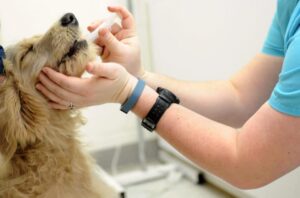This guide to dog diabetes gives practical advice on caring for your pet and stress-free monitoring to help you stay in control of canine diabetes. When your best buddy is diagnosed with canine diabetes, it’s natural to feel anxious and overwhelmed. But you shouldn’t be daunted by dog diabetes because the condition can be controlled and your pet pal can lead a full, active life.
An Introduction to Dog Diabetes
When the ‘perfect storm’ of risk factors aligns, a dog from a breed prone to diabetes may tip over into clinical disease.
What Causes Canine Diabetes?
Sugar diabetes in dogs is commonly the result of a lack of the sugar regulating hormone, insulin. This under-production of insulin can happen if the body’s immune system attacks the pancreas (the factory making insulin), or the dog has pancreatitis (inflammation of the pancreas), or due to genetic factors. To complicate the picture, other dog health factors can reduce the ability of body tissue to bind with insulin and what little hormone is present becomes less effective. These other health problems include obesity, Cushing’s disease, underactive thyroid glands, acromegaly (too much growth hormone), and infections.
Dog Breeds at Increased Risk of Diabetes
A quirk of fate means that some breeds are more likely to develop dog diabetes than others. These breeds include: Australian Terrier Standard Schnauzer Miniature Schnauzer Bichon Frise Spitz Fox Terrier Miniature Poodle Samoyed Cairn Terrier Keeshond Maltese Toy Poodle Lhasa Apso Yorkshire Terrier This doesn’t mean your purebred dog will inevitably develop diabetes. Only a small percentage will develop diabetes, but it is wise to reduce the risk by keeping your dog healthy, slim, and active.
What are the Signs of Diabetes in Dogs?
Any change from your dog’s regular habits warns of a possible dog health problem. In common with many dog diseases, the signs of diabetes are quite general and include increased thirst and urination, weight loss despite a good appetite, and lack of energy. Diabetes also weakens the immune system so the dog may have repeat infections. The good news is the sooner this dog health problem is spotted, the easier it is to treat and with fewer complications. Common signs a problem is brewing include:
- Drinking more: Are you constantly refilling the water bowl?
- Big wees: The dog may need to go out more often or has accidents overnight
- Always hungry: The dog nags for more food
- Weight loss: Despite a good appetite, the dog loses weight
As the diabetes becomes established other symptoms develop, such as:
- Cataracts: Cloudy lens can mean the dog can’t see well and bumps into things
- Poor coat: The once luxurious fur becomes dull and dry
- Bad breath: An unpleasant odor, similar to nail polish remover, lingers on the dog’s breath
- Lethargy: The dog lacks energy and lags behind on walks
- Weakness: He may struggle to get up and lose interest in playing
- Coma: In the severest cases the dog may lapse into a coma
Early detection of dog diabetes makes all the difference. If you spot something isn’t quite right, don’t ignore it in the hope the problem will go away. Instead, be proactive and seek veterinary help to get your pet back on his paws.

A thirsty dog may have a health problem such as diabetes.
Life with a Dog with Diabetes
OK, so your dog is diagnosed with diabetes: What will life be like?
Life Expectancy
Experts tell us that the average diabetic dog lives for around 2.7 years after diagnosis, and for dogs with good glucose control there may be little impact on their life expectancy. Certainly an incentive to get things right!
Changes to Routine
Arguably the biggest impact on life is that a diabetic dog needs a structured day. He requires regular meals at a set schedule, followed by an insulin injection. You’ll also need to monitor factors such as appetite, thirst, activity levels, and attitude.
Alerts to Catastrophe
If you can’t be present in person to watch for telltale signs of distress or dangerously low blood sugar, then a PetPace collar provides a solution. The collar allows you to remotely monitor how active (or not) your dog is, along with his breathing patterns and heart rate – giving you a valuable warning if the condition deteriorates. With the information sent real-time to your smartphone, you can check on the dog any time and, if required, schedule an urgent trip home.
Monitoring Blood Sugar Levels
Dog diabetes is managed differently than human diabetes. With dogs, insulin injections are usually given twice a day, rather than every few hours as in people. You or your vet may run a blood glucose curve whilst the dog is being stabilized and the ideal dose of insulin determined. This can be done at the vet’s office, or with a little training you can use a glucometer at home. Blood glucose levels are monitored for two reasons:
- To determine the dose of insulin
- To check for dangerously low blood sugar
You may also need to test the dog’s urine with urinary dipsticks. The dipstick checks the amount of sugar and ketones in the dog’s sample. Of these, be alert for ketones, a toxin arising due to prolonged high sugar levels. Ketones are a clue the dog isn’t stable. The dipstick should read negative for ketones, and if they are present then you should consult your vet.
Exercise and the Diabetic Dog
When a dog is overweight, his diabetes is more difficult to stabilize. Starting a tailored weight loss program and exercise regime makes a big difference to the dog’s diabetes control. However, be careful to keep the amount of exercise consistent, day after day. This is to avoid big fluctuations in the body’s need for energy, as an exceptionally long walk could cause blood sugar levels to drop. Again, a PetPace collar helps monitor how much the dog walks each day, helping you avoid over-doing things.
Treating a Dog with Diabetes
Insulin Injections
Key to treating diabetes are regular (once or twice daily) insulin injections. The vet will determine the best dose for your dog, and teach you how to inject it at home. Be sure to follow their instructions closely and store the insulin away from direct heat or light. Insulin injections are given after the dog has eaten, so the insulin is there to cope with rising blood sugar levels. If the dog refuses to eat, most vets advice giving a half dose of insulin, but if you are worried or the dog refuses a second meal, always phone the vet for advice.
Doggie Diabetic Diets
Just as a human diabetic has to be careful what they eat, so does a dog. In fact, the rules are pretty similar in that a sugar rush should be avoided (so no highly processed foods such as biscuits, sweets, or junk food).

Doggie diabetics should eat food rich in complex carbohydrates and fiber. Both of these things lead to slow sustained energy release and avoid a post-prandial sugar spike. And if you’re scratching your head wondering what a complex carbohydrate is, it’s generally food as nature intended, like vegetables, rice, pasta, or whole meal bread. However, formulating a balanced home-cooked diet is difficult at the best of times. Take the headache out of feeding a prescription diet designed for diabetic dogs. These contain a careful balance of soluble and insoluble fiber, along with complex carbohydrates, to keep blood sugar levels steady.
Keeping Things Sweet
Owning a diabetic dog is a commitment and diligence but it’s also a rewarding one. Get things going in your favor with steady exercise, a good diet, and regular insulin injections. And for the times you can’t be there to watch over the dog, a PetPace collar will give you peace of mind.

